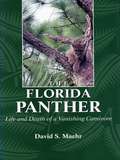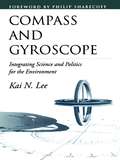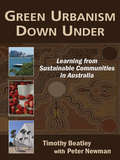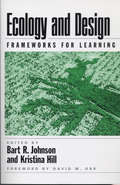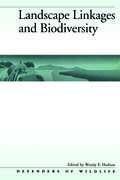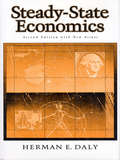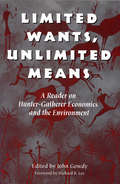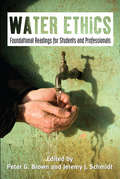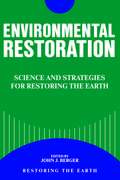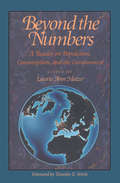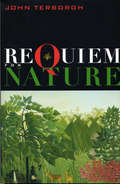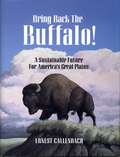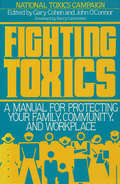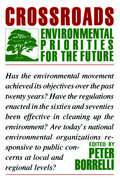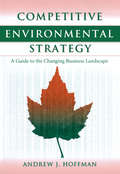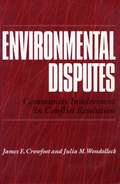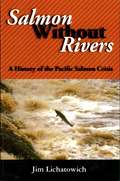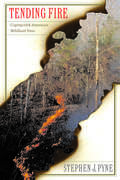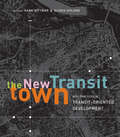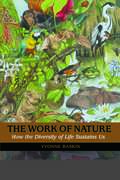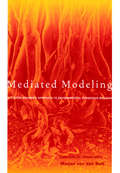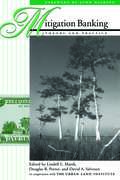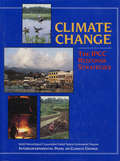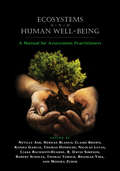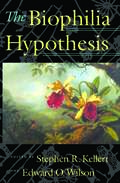- Table View
- List View
The Florida Panther: Life And Death Of A Vanishing Carnivore
by David MaehrWhen the first field study of the Florida panther took place in 1973, so little was known about the animal that many scientists believed it was already extinct. During more extensive research conducted from 1981 to 1986, panthers were proven to exist, but the handful of senile, anemic, and parasite-infested specimens that were captured indicated a grim future. During those early years a remarkably enduring image of the panther was born, and despite voluminous data gathered over the next decade that showed the panther to be healthy, long-lived, and reproducing, that earlier image has yet to be dispelled. For nine years, biologist David S. Maehr served as project leader of the Florida Panther Study Project, helping to gather much of the later, surprisingly positive data. In The Florida Panther, he presents the first detailed portrait of the animal -- its biology, natural history, and current status -- and a realistic assessment of its prospects for survival. Maehr also provides an intriguing look at the life and work of a field biologist: how captures are made, the intricacies of radio-telemetry tracking, the roles of various team members. He describes the devastating intrusion of politics into scientific work and examines controversial efforts to establish a captive breeding program and to manipulate the Florida panther's genetic stock with the introduction of relatives from west Texas. Protection of high-quality habitat, much of it in the hands of private landowners, is the key to the long-term survival of the Florida panther. Unless agency decisionmakers and the public are aware of the panther's true situation, little can be done to save it. This book will play a vital role in correcting widespread misconceptions about the panther's current condition and threats to its survival.
Compass and Gyroscope: Integrating Science And Politics For The Environment
by Philip Shabecoff Kai N. LeeUsing the Columbia River Basin in the Pacific Northwest as a case study, Kai Lee describes the concept and practice of "adaptive management," as he examines the successes and failures of past and present management experiences. Throughout the book, the author delves deeply into the theoretical framework behind the real-world experience, exploring how theories of science, politics, and cognitive psychology can be integrated into environmental management plans to increase their effectiveness.
Green Urbanism Down Under: Learning from Sustainable Communities in Australia
by Timothy Beatley Peter NewmanIn this immensely practical book, Timothy Beatley sets out to answer a simple question: what can Americans learn from Australians about "greening" city life? Green Urbanism Down Under reports on the current state of "sustainability practice" in Australia and the many lessons that U.S. residents can learn from the best Australian programs and initiatives. Australia is similar to the United States in many ways, especially in its "energy footprint." For example, Australia's per capita greenhouse gas emissions are second only to those of the United States. A similar percentage of its residents live in cities (85 percent in Australia vs. 80 percent in the United States). And it suffers from parallel problems of air and water pollution, a national dependence on automobiles, and high fossil fuel consumption. Still, after traveling throughout Australia, Beatley finds that there are myriad creative responses to these problems--and that they offer instructive examples for the United States. Green Urbanism Down Under is a very readable collection of solutions. Although many of these innovative solutions are little-known outside Australia, they all present practical possibilities for U.S. cities. Beatley describes "green transport" projects, "city farms," renewable energy plans, green living programs, and much more. He considers a host of public policy initiatives and scrutinizes regional and state planning efforts for answers. In closing, he shares his impressions about how Australian results might be applied to U.S. problems. This is a unique book: hopeful, constructive, and filled with ideas that have been proven to work. It is a "must read" for anyone who cares about the future of American cities.
Ecology and Design: Frameworks For Learning
by Kristina Hill Robert Melnick Bart JohnsonProfessionals, faculty, and students are aware of the pressing need to integrate ecological principles into environmental design and planning education, but few materials exist to facilitate that development.Ecology and Design addresses that shortcoming by articulating priorities and approaches for incorporating ecological principles in the teaching of landscape design and planning. The book explains why landscape architecture and design and planning faculty should include ecology as a standard part of their courses and curricula, provides insights on how that can be done, and offers models from successful programs. The book: examines the need for change in the education and practice of landscape architecture and in the physical planning and design professions as a whole asks what designers and physical planners need to know about ecology and what applied ecologists can learn from design and planning develops conceptual frameworks needed to realize an ecologically based approach to design and planning offers recommendations for the integration of ecology within a landscape architecture curriculum, as an example for other design fields such as civil engineering and architecture considers the implications for professional practice explores innovative approaches to collaboration among designers and ecologistsIn addition to the editors, contributors include Carolyn Adams, Jack Ahern, Richard T. T. Forman, Michael Hough, James Karr, Joan Iverson Nassauer, David Orr, Kathy Poole, H. Ronald Pulliam, Anne Whiston Spirn, Sandra Steingraber, Carl Steinitz, Ken Tamminga, and William Wenk. Ecology and Design represents an important guidepost and source of ideas for faculty, students, and professionals in landscape architecture, urban design, planning and architecture, landscape ecology, conservation biology and restoration ecology, civil and environmental engineering, and related fields.
Landscape Linkages and Biodiversity: Policies For A Sustainable Future
by Larry Harris Michael E. Soulé J. Michael Scott Wendy E. Hudson Blair Csuti Keith HayIn Landscape Linkages and Biodiversity experts explain biological diversity conservation, focusing on the need for protecting large areas of the most diverse ecosystems, and connecting those ecosystems with land corridors to allow species to move among them more easily.
Steady-State Economics: Second Edition With New Essays (Advances In Ecological Economics Ser.)
by Herman E. DalyFirst published in 1977, this volume caused a sensation because of Daly's radical view that "enough is best." Today, his ideas are recognized as the key to sustainable development, and Steady-State Economics is universally acknowledged as the leading book on the economics of sustainability.
Limited Wants, Unlimited Means: A Reader On Hunter-Gatherer Economics And The Environment
by John GowdyFor roughly 99% of their existence on earth, Homo sapiens lived in small bands of semi-nomadic hunter-gatherers, finding everything they needed to survive and thrive in the biological richness that surrounded them. Most if not all of the problems that threaten our own technologically advanced society -- from depletion of natural capital to the ever-present possibility of global annihilation -- would be inconceivable to these traditional, immediate-return societies. In fact, hunter-gatherer societies appear to have solved problems of production, distribution, and social and environmental sustainability that our own culture seems incapable of addressing.Limited Wants, Unlimited Means examines the hunter-gatherer society and lifestyle from a variety of perspectives. It provides a brief introduction to the rich anthropological and sociological literature on non-agricultural societies, bringing together in one volume seminal writings on the few remaining hunter-gatherer cultures including, the !Kung, the Hadza, and the Aborigines. It examines the economics of traditional societies, and concludes with a multifaceted investigation of how such societies function and what they can teach us in our own quest for environmental sustainability and social equality.Limited Wants, Unlimited Means is an important work for students of cultural anthropology, economic anthropology, environmental studies, and sustainable development, as well as for professionals, researchers, and anyone interested in prehistoric societies, environmental sustainability, or social justice.
Water Ethics: Foundational Readings for Students and Professionals
by Peter G. Brown Jeremy J. SchmidtHaving manipulated water for irrigation, energy, and burgeoning urban centers, humans are facing the reality that although fresh water is renewable, it is as finite as any other resource. Countries, states, and cities are now scrambling to develop an intelligent, well-informed approach to mitigate the growing global water crisis. Water Ethics is based on the belief that responding to contemporary water problems requires attending to questions of value and culture. How should we capture, store, and distribute water? At what cost? For whom? How do we reconcile water's dual roles as a practical resource and spiritual symbol? According to the editors of this collection of foundational essays, questions surrounding water are inherently ethical. Peter Brown and Jeremy Schmidt contend that all approaches to managing water, no matter how grounded in empirical data, involve value judgments and cultural assumptions. Each of the six sections of the book discuses a different approach to thinking about the relationship between water and humanity, from utilitarianism to eco-feminism to religious beliefs, including Islam, Hinduism, and Christianity. Contributors range from Bartholemew, Ecumenical Patriarch of the Orthodox Church to Nobel Laureate economist Elinor Ostrom and water policy expert Sandra Postel. Each section is framed by an original introductory essay written by the editors. Water Ethics will help readers understand how various moral perspectives, even when unstated, have guided and will continue to guide water policy around the globe.
Environmental Restoration: Science And Strategies For Restoring The Earth
by John BergerEnvironmental Restoration is the product of a ground-breaking conference on ecological restoration, held in January 1988 at the University of California, Berkeley. It offers an overview from the nation's leading experts of the most current techniques of restoration, including examples of the complex and subtle biological interactions we must understand to ensure success.Chapters cover restoration of agricultural lands, barrens, coastal ecosystems, prairies, and range lands. Additional sections address temperate forests and watersheds, mined lands, soil bioengineering, urban issues including waste treatment and solid, toxic, and radioactive waste management. The book also covers restoration of aquatic systems, includes chapters on strategic planning and land acquisition, and provides examples of successful projects.
Beyond the Numbers: A Reader on Population, Consumption and the Environment
by Judy Norsigian Sharon Stanton Russell G. Rathjens J. Boutwell Adrienne Germain David E. HorlacherBeyond the Numbers presents a thought-provoking series of essays by leading authorities on issues of population and consumption. The essays both define the poles of debate and explore common ground beyond the polarized rhetoric.Specific chapters consider each of the broad topics addressed at the International Conference on Population and Development held in September 1994 in Cairo, Egypt. The essays are supplemented by sidebars and short articles featuring more-impassioned voices that highlight issues of interest not fully explored in the overviews.As well as providing a sense of the difficulties involved in dealing with these issues, the essays make clear that constructive action is possible.Topics covered include: the interrelationships between population, economic growth, consumption, and development the history of population and family planning efforts gender equality and the empowerment of women reproductive rights, reproductive health, family planning, health and mortality
Requiem for Nature
by John TerborghFor ecologist John Terborgh, Manu National Park in the rainforest of Peru is a second home; he has spent half of each of the past twenty-five years there conducting research. Like all parks, Manu is assumed to provide inviolate protection to nature. Yet even there, in one of the most remote corners of the planet, Terborgh has been witness to the relentless onslaught of civilization.Seeing the steady destruction of irreplaceable habitat has been a startling and disturbing experience for Terborgh, one that has raised urgent questions: Is enough being done to protect nature? Are current conservation efforts succeeding? What could be done differently? What should be done differently? In Requiem for Nature, he offers brutally honest answers to those difficult questions, and appraises the prospects for the future of tropical conservation. His book is a clarion call for anyone who cares about the quality of the natural world we will leave our children.Terborgh examines current conservation strategies and considers the shortcomings of parks and protected areas both from ecological and institutional perspectives. He explains how seemingly pristine environments can gradually degrade, and describes the difficult social context -a debilitating combination of poverty, corruption, abuses of power, political instability, and a frenzied scramble for quick riches -in which tropical conservation must take place. He considers the significant challenges facing existing parks and examines problems inherent in alternative approaches, such as ecotourism, the exploitation of nontimber forest products, "sustainable use," and "sustainable development."Throughout, Terborgh argues that the greatest challenges of conservation are not scientific, but are social, economic, and political, and that success will require simultaneous progress on all fronts. He makes a compelling case that nature can be saved, but only if good science and strong institutions can be thoughtfully combined.
Bring Back the Buffalo!: A Sustainable Future For America's Great Plains
by Ernest Callenbach Hans CallenbachIn Bring Back the Buffalo!, Ernest Callenbach argues that the return of the bison is the key to a sustainable future for the Great Plains. Vast stretches of the region have seen a steady decline in population and are ill-suited for traditional agriculture or cattle ranching. Yet those same areas provide ideal habitat for bison. Callenbach explores the past history, present situation, and future potential of bison in North America as he examines what can and should be done to re-establish bison as a significant presence in the American landscape. He looks forward with high hopes to a time when vast herds of buffalo provide permanent sustenance to the rural inhabitants of the Great Plains and again play a central role in the balance of nature.
Fighting Toxics: A Manual for Protecting your Family, Community, and Workplace
by John O'Connor Barry Commoner Gary Cohen Barry National Toxics CampaignFighting Toxics is a step-by-step guide illustrating how to investigate the toxic hazards that may exist in your community, how to determine the risks they pose to your health, and how to launch an effective campaign to eliminate them.
Crossroads: Environmental Priorities For The Future
by James Gustave Speth Barry Commoner Robert Boyle Cynthia Wilson Richard S. Booth Amos EnoThe environmental movement today is at a critical crossroads. Crossroads: Environmental Priorities for the Future is an in-depth assessment of the movement's successes and failures, and also offers prescriptions for the future. It includes contributions from some of the country's top environmental leaders and activists, including Barry Commoner, Stewart Udall, William K. Reilly, Gus Speth, Jay Hair, Lois Gibbs, Michael Frome, Chuck Little, and William Futrell.
Competitive Environmental Strategy: A Guide To The Changing Business Landscape
by Andrew J. HoffmanEnvironmental concerns can greatly affect business success, regardless of whether a business person or corporation shares those concerns. Today's corporate managers must understand the power of environmental issues, and shift their mindset from one focused on environmental "management" to one focused on strategy.Competitive Environmental Strategy examines the effects of environmentalism on corporate management, explaining how and why environmental forces are driving change and how business managers can think about environmental issues in a strategic way. The author discusses: the evolving drivers of corporate environmental strategy, including regulators, shareholders, buyers and suppliers, insurers, investors, and consumers how environmentalism alters basic conceptions of competitive strategy and organizational design how external institutions create both opportunity and limitations for environmental strategy how environmental threats can be incorporated into risk management, capital acquisition, competitive position, and other management concerns The book ends with an overall discussion of competitive environmental strategy and draws connections to the emerging issue of sustainable development. Each chapter features insets that ask fundamental questions about the relationship between environmental protection and business strategy, and ends with a list of additional recommended readings. Every individual who wishes to engage in business management in the 21st century will need an appreciation for the implications of environmental issues on corporate activities, and vice-versa.Competitive Environmental Strategy offers a valuable overview of the subject, and provides a wealth of real-world examples that demonstrate the validity and applicability of the concepts for business people, clearly showing how managers are turning an understanding of environmental issues to competitive advantage.
Environmental Disputes: Community Involvement In Conflict Resolution (Environment, Development And Public Policy: Environmental Policy And Planning Ser.)
by Julia M. Wondolleck James CrowfootEnvironmental Disputes helps citizen groups, businesses, and governments understand how Environmental Dispute Settlement--a set of procedures for settling disputes over environmental policies without litigation--can work for them.
Salmon Without Rivers: A History Of The Pacific Salmon Crisis
by James A. LichatowichFrom a mountain top where an eagle carries a salmon carcass to feed its young to the oceanic waters of the California current and the Alaskan Gyre, salmon have penetrated the Northwest to an extent unmatched by other animals. Since the turn of the twentieth century, natural productivity of salmon in Oregon, Washington, California, and Idaho has declined 80 percent. The decline of Pacific salmon to the brink of extinction is a sign of serious problems in the region.In Salmon Without Rivers, fisheries biologist Jim Lichatowich offers an eye-opening look at the roots and evolution of the salmon crisis in the Pacific Northwest. He describes the multitude of factors over the past century and a half that have led to the salmon's decline, and examines the failure of restoration efforts that have focused almost exclusively on hatcheries to return salmon stocks to healthy levels without addressing underlying causes of the decline.Lichatowich argues that the dominant worldview of our society -- a worldview that denies connections between humans and the natural world -- has created the conflict that characterizes the recent history of salmon; unless that worldview is challenged, there is little hope for recovery. Salmon Without Rivers exposes the myths that have guided recent human-salmon interactions. It explains the difficult choices facing citizens of the region, and provides unique insight into one of the most tragic chapters in our nation's environmental history.
Tending Fire: Coping With America's Wildland Fires
by Stephen PyneThe wildfires that spread across Southern California in the fall of 2003 were devastating in their scale-twenty-two deaths, thousands of homes destroyed and many more threatened, hundreds of thousands of acres burned. What had gone wrong? And why, after years of discussion of fire policy, are some of America's most spectacular conflagrations arising now, and often not in a remote wilderness but close to large settlements?That is the opening to a brilliant discussion of the politics of fire by one of the country's most knowledgeable writers on the subject, Stephen J. Pyne. Once a fire fighter himself (for fifteen seasons, on the North Rim of the Grand Canyon) and now a professor at Arizona State University, Pyne gives us for the first time a book-length discussion of fire policy, of how we have come to this pass, and where we might go from here.Tending Fire provides a remarkably broad, sometimes startling context for understanding fire. Pyne traces the "ancient alliance" between fire and humanity, delves into the role of European expansion and the creation of fire-prone public lands, and then explores the effects wrought by changing policies of "letting burn" and suppression. How, the author asks, can we better protect ourselves against the fires we don't want, and better promote those we do?Pyne calls for important reforms in wildfire management and makes a convincing plea for a more imaginative conception of fire, though always grounded in a vivid sense of fire's reality. "Amid the shouting and roar, a central fact remains," he writes. "Fire isn't listening. It doesn't feel our pain. It doesn't care-really, really doesn't care. It understands a language of wind, drought, woods, grass, brush, and terrain, and it will ignore anything stated otherwise."Rich in insight, wide-ranging in its subject, and clear-eyed in its proposals, Tending Fire is for anyone fascinated by fire, fire policy, or human culture.
The New Transit Town: Best Practices In Transit-Oriented Development
by Hank Dittmar Gloria OhlandTransit-oriented development (TOD) seeks to maximize access to mass transit and nonmotorized transportation with centrally located rail or bus stations surrounded by relatively high-density commercial and residential development. New Urbanists and smart growth proponents have embraced the concept and interest in TOD is growing, both in the United States and around the world.New Transit Town brings together leading experts in planning, transportation, and sustainable design--including Scott Bernstein, Peter Calthorpe, Jim Daisa, Sharon Feigon, Ellen Greenberg, David Hoyt, Dennis Leach, and Shelley Poticha--to examine the first generation of TOD projects and derive lessons for the next generation. It offers topic chapters that provide detailed discussion of key issues along with case studies that present an in-depth look at specific projects. Topics examined include:*the history of projects and the appeal of this form of development*a taxonomy of TOD projects appropriate for different contexts and scales*the planning, policy and regulatory framework of "successful" projects*obstacles to financing and strategies for overcoming those obstacles*issues surrounding traffic and parking*the roles of all the actors involved and the resources available to them*performance measures that can be used to evaluate outcomesNew Transit Town explores the key challenges to transit-oriented development, examines the lessons learned from the first generation of projects, and uses a systematic examination and analysis of a broad spectrum of projects to set standards for the next generation. It is a vital new source of information for anyone interested in urban and regional planning and development, including planners, developers, community groups, transit agency staff, and finance professionals.
The Work of Nature: How The Diversity Of Life Sustains Us
by Paul R. Ehrlich Harold A. Mooney Abigail Rorer Yvonne Baskin Jane Lubchenco"We do not question that flesh and bone and leaf litter will decay to dust, that seeds will sprout season after season and find renewed nourishment in the soil, that rivers can flow endlessly without running dry, that we can breathe a lifetime without depleting the air of oxygen.... What humans have not fully appreciated until recently is that these services are the work of nature, performed by the rich diversity of microbes, plants, and animals on the earth." --from The Work of NatureThe lavish array of organisms known as "biodiversity" is an intricately linked web that makes the earth a uniquely habitable planet. Yet pressures from human activities are destroying biodiversity at an unprecedented rate. How many species can be lost before the ecological systems that nurture life begin to break down?In The Work of Nature, noted science writer Yvonne Baskin examines the threats posed to humans by the loss of biodiversity. She summarizes and explains key findings from the ecological sciences, highlighting examples from around the world where shifts in species have affected the provision of clean air, pure water, fertile soils, lush landscapes, and stable natural communities.As Baskin makes clear, biodiversity is much more than number of species -- it includes the complexity, richness, and abundance of nature at all levels, from the genes carried by local populations to the layout of communities and ecosystems across the landscape. Ecologists are increasingly aware that mankind's wanton destruction of living organisms -- the planet's work force -- threatens to erode our basic life support services. With uncommon grace and eloquence, Baskin demonstrates how and why that is so.Distilling and bringing to life the work of the world's leading ecologists, The Work of Nature is the first book of its kind to clearly explain the practical consequences of declining biodiversity on ecosystem health and function.
Mediated Modeling: A System Dynamics Approach To Environmental Consensus Building
by Marjan van den Belt Thomas DietzMediated modeling is an innovative new approach that enhances the use of computer models as invaluable tools to guide policy and management decisions. Rather than having outside experts dispensing answers to local stakeholders, mediated modeling brings together diverse interests to raise the shared level of understanding and foster a broad and deep consensus. It provides a structured process based on system dynamics thinking in which community members, government officials, industry representatives, and other stakeholders can work together to produce a coherent, simple but elegant simulation model. Mediated Modeling by Marjan Van Den Belt is a practical guide to participatory modeling for both practitioners and students, one that is firmly theoretically grounded in the field of systems dynamics and environmental modeling. Five in-depth case studies describe the successful use of the technique in a variety of settings, and a final chapter synthesizes the lessons highlighted by the case studies.Mediated Modeling's step-by-step description of the techniques and practical advice regarding implementation offer a real-world solution for all those seeking to make sound decisions about the environment.
Mitigation Banking: Theory And Practice
by Douglas R. Porter David Salvesen John De Grove Lindell L. MarshUnder the Clean Water Act, development that results in the permanent destruction of wetlands must, in most cases, be mitigated by the creation of a new wetland or the restoration of a degraded one. In recent years, the concept of "mitigation banking" has emerged. Rather than require developers to create and maintain wetlands on their own on a quid pro quo basis, mitigation banking allows them to pay for wetlands that have been created and maintained properly by others to compensate for their damage.The contributors to this volume provide an overview of mitigation banking experience in the United States, examine the key issues and concerns -- from providing assurances to determining the value of credits -- and describe the practice of developing and operating a mitigation bank. Topics include: history and current experience of mitigation banking policies and concerns of local, state, and federal agencies economics of mitigation banking funding, management, and operation of banks starting a mitigation bank
Climate Change: The Ipcc Response Strategies
by Intergovernmental Panel on Climate ChangeClimate Change is the report of Working Group III of the Intergovernmental Panel on Climate Change (IPCC), established in 1988 by the World Meteorological Organization and UNEP to address the threat of global warming on an international scale.
Ecosystems and Human Well-Being: A Manual for Assessment Practitioners (Five Volume Set Ser.)
by Thomas Tomich Monika Zurek Neville Ash Hernán Blanco Keisha Garcia Bhaskar ViraDesigned by a partnership of UN agencies, international scientific organizations, and development agencies, the Millennium Ecosystem Assessment (MA) is the most extensive study ever of the linkages between the world's ecosystems and human well-being. The goal of the MA is to establish the scientific basis for actions needed to enhance the contribution of ecosystems to human well-being without undermining their long-term productivity. With contributions by more than 500 scientists from 70 countries, the MA has proven to be one of the most important conservation initiatives ever undertaken, and the ecosystem services paradigm on which it is based provides the standard for practice. This manual supplies the specific tools that practitioners of the paradigm need in order to extend their work into the future. The manual is a stand-alone "how to" guide to conducting assessments of the impacts on humans of ecosystem changes. In addition, assessment practitioners who are looking for guidance on particular aspects of the assessment process will find individual chapters of this manual to be useful in advancing their understanding of best practices in ecosystem assessment. The manual builds on the experiences and lessons learned from the Millennium Ecosystem Assessment global and sub-global assessment initiatives, with chapters written by well-known participants in those initiatives. It also includes insights and experiences gained from a wider range of ecosystem service-focused assessment activities since the completion of the MA in 2005.
The Biophilia Hypothesis: The Quest To Make Conservation Profitable
by Edward O. Wilson Stephen R. Kellert Gregory Wilkins Aaron Katcher Cecilia Mccarthy Scott Mcvay"Biophilia" is the term coined by Edward O. Wilson to describe what he believes is humanity's innate affinity for the natural world. In his landmark book Biophilia, he examined how our tendency to focus on life and lifelike processes might be a biologically based need, integral to our development as individuals and as a species. That idea has caught the imagination of diverse thinkers.The Biophilia Hypothesis brings together the views of some of the most creative scientists of our time, each attempting to amplify and refine the concept of biophilia. The variety of perspectives -- psychological, biological, cultural, symbolic, and aesthetic -- frame the theoretical issues by presenting empirical evidence that supports or refutes the hypothesis. Numerous examples illustrate the idea that biophilia and its converse, biophobia, have a genetic component: fear, and even full-blown phobias of snakes and spiders are quick to develop with very little negative reinforcement, while more threatening modern artifacts -- knives, guns, automobiles -- rarely elicit such a response people find trees that are climbable and have a broad, umbrella-like canopy more attractive than trees without these characteristics people would rather look at water, green vegetation, or flowers than built structures of glass and concrete The biophilia hypothesis, if substantiated, provides a powerful argument for the conservation of biological diversity. More important, it implies serious consequences for our well-being as society becomes further estranged from the natural world. Relentless environmental destruction could have a significant impact on our quality of life, not just materially but psychologically and even spiritually.
